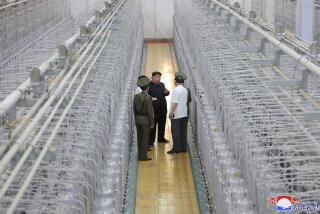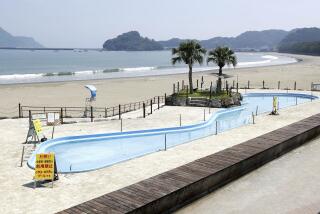Japan closes nuclear plant after quake
- Share via
TOKYO — Officials ordered the world’s largest nuclear power plant to be idled indefinitely Wednesday after the government acknowledged that it had not been built to withstand the force of an earthquake that hit Japan’s west coast, and that it probably sits atop a previously undisclosed active fault.
The revelations are a blow to Japan’s massive nuclear power industry, which already suffers from a reputation for questionable safety standards and a record of hiding accidents.
The latest troubles could have broad implications for plans to increase the percentage of electricity that comes from nuclear energy in an economic powerhouse that rests on highly volatile geological plates but has little coal, and no oil or natural gas.
Japan already generates about a third of its electricity from nuclear power. Like a number of other countries, it sees nuclear power as a means to meet its goals for limiting emissions of the greenhouse gases that contribute to global warming.
The government previously rejected claims that the plant was atop an active fault.
“It is possible that the epicenter of the fault line runs under the power plant,” said Akira Fukushima, deputy director-general for safety at the Industry Ministry’s nuclear agency.
He said the revised opinion was based on an examination of aftershock data from Monday’s 6.8 magnitude quake by the Japan Meteorological Agency. The new data show that Monday’s quake was centered six miles below the seabed just offshore, but the fault extends inland and includes the area under the plant.
“This earthquake was much bigger than the plant had been designed for,” said Fukushima, who added that the government was examining whether the country’s other nuclear reactors meet tougher design standards introduced last year.
Investigators also revealed that the Kashiwazaki plant suffered more damage than they first acknowledged, undercutting official reassurances that Japan’s nuclear plants are earthquake-proof.
After initially giving an all-clear, Tokyo Electric Power Co., or Tepco, which owns and operates the plant, now says it has uncovered 53 quake-related problems, including the fire that broke out in an electrical transformer, broken pipes and low levels of radioactivity in ventilation stack filters.
The company also raised the count of drums containing nuclear waste that were knocked over by the jolting. Original reports said 100 barrels had toppled from their stacks in a storage facility that contains about 10,000 drums. But a Tepco spokesman said Wednesday that as many as 400 barrels had tipped over. Forty were found with their lids off and their contents spilled.
Tepco also said its initial calculations about the amount of radioactivity leaked into the Sea of Japan were based on incorrect assumptions, and that radioactivity levels were 50% higher than previously acknowledged. Those amounts were still minuscule, government and Tepco officials said, amounting to just “onebillionth” of legally permissible radiation.
“It does not pose a danger to humanity or the environment,” Fukushima said.
Japan already has 55 nuclear plants, and its national energy plan calls for nuclear power to meet as much as 40% of the country’s demand by 2010.
But critics long have warned that many of the country’s 1970s- and ‘80s-vintage plants are vulnerable to earthquakes. A prime cause of concern to many experts is the Hamaoka plant, which sits atop an active fault on a peninsula just 100 miles southwest of Tokyo.
Last year, the government toughened its guidelines to make nuclear plants earthquake resistant, a tacit acknowledgment that its existing regulations had been based on outdated geological data. Since then, it has been conducting a review of whether any reactors need to be shored up.
Public skepticism about the safety of Japan’s nuclear power plants has been nurtured by a slowly emerging pattern of questionable safety habits and cover-ups.
Tepco’s 17 nuclear plants were temporarily shut down in 2003 after it admitted it had falsified safety inspection reports. And owners of the Shika nuclear plant revealed in March that they had suffered a critical accident in 1999.
Until this week, the government and Tepco had vociferously denied claims that the facility’s seven reactors sat above an active fault.
In 2005, government experts defended and won a court challenge brought against the power company by a local citizens group, which argued that the plant should not be allowed to build additional reactors because the area was an active earthquake zone.
“The nuclear power industry is terrible about disclosing information,” said Yoshinori Ito, a lawyer who represented the citizens group.
He accused the government witnesses in the case of being too timid to contradict the scholars who had provided the initial data that allowed construction to proceed.
The court declared that the ground under Kashiwazaki “did not even amount to a fault and could not cause a quake.”
Public skepticism has clearly hardened in the wake of Monday’s tremor, which killed 10 people.
On Wednesday, the mayor of Kashiwazaki, a city of about 93,000 people, ordered Tepco executives to keep the plant closed until it could be certified as safe. The government’s industry minister made a public show of summoning and reprimanding the company president.
But dependence on nuclear energy puts the Japanese in a tight spot.
Suspension of operations at Kashiwazaki might lead to short-term energy shortages in the world’s third-largest nuclear power producer. The plant provides about 7% of Tepco’s output, and the power shortage already has had wider economic effects: a key auto parts maker in the region was forced to shut down, leading Toyota and other auto manufacturers to scale back production at some plants.
Nor is there any certainty that the bad news from Kashiwazaki is over.
“There were no abnormalities in areas of the plant where safety standards are very high, but we are still investigating,” said government safety expert Fukushima, arguing that the reactor shutdown proved that the existing seismic detection system worked.
“The great concern we have right now is that the fault line not have an impact on the plant,” he said.
--
More to Read
Sign up for Essential California
The most important California stories and recommendations in your inbox every morning.
You may occasionally receive promotional content from the Los Angeles Times.













